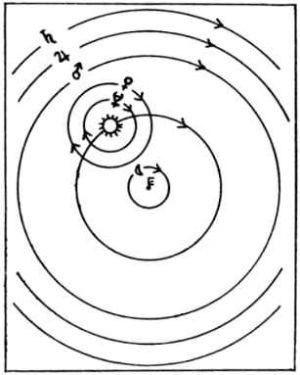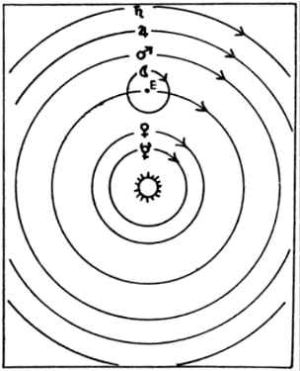The Sleepwalkers (19 page)
Authors: Arthur Koestler



(A)
Classical
geocentric
system
(B)
"Egyptian"
system
of
Herakleides


(C)
System of Tycho de Brahe (and of Herakleides?) (D) Aristarchus'
heliocentric system.
=
Sun;
=
Moon;
E
=
Earth;
f
=
Mercury;
g
=
Venus;
h
=
Mars;
F
=
Jupiter;
G
=
Saturn
But
model
A
could
never
be
made
to
work
properly.
To
our
hind-sight,
the
reason
is
obvious:
the
planets
were
arranged
in
the
wrong
order;
the
sun
should
be
in
the
centre,
and
the
earth
should
take
the
sun's
place
between
the
"lower"
and
"upper"
planets,
taking
the
moon
with
her
(Fig.
D).
This
basic
fault
in
the
model
caused
incomprehensible
irregularities
in
the
apparent
motions
of
the
planets.
By
the
time
of
Herakleides,
these
irregularities
had
become
the
principal
worry
of
the
philosophers
concerned
with
the
universe.
The
sun
and
moon
seemed
to
move
in
a
more
or
less
regular
manner
along
the
traffic
lane;
but
the
five
planets
travelled
in
a
most
erratic
way.
A
planet
would
amble
for
a
while
along
the
lane,
in
the
general
direction
of
the
traffic,
West
to
East;
but
at
intervals
he
would
slow
down,
come
to
a
stop
as
if
he
had
reached
a
station
in
the
sky,
and
retrace
his
steps;
then
change
his
mind
again,
turn
round
and
resume
his
wandering
in
the
original
direction.
Venus
behaved
even
more
capriciously.
The
pronounced
periodical
changes
in
her
brightness
and
size
seemed
to
indicate
that
she
alternately
approached
and
receded
from
us,
and
this
suggested
that
she
did
not
really
move
in
a
circle
round
the
earth,
but
along
some
unthinkable,
wavy
line.
Moreover,
both
she
and
Mercury,
the
second
inner
planet,
now
raced
ahead
of
the
steadily
moving
sun,
now
fell
behind,
but
always
stuck
close
to
him,
like
dolphins
playing
around
a
ship.
Accordingly,
Venus
at
times
appeared
as
Phosphoros
the
"morning
star",
rising
with
the
sun
in
her
wake,
at
other
times
as
Hesperos
the
"evening
star"
at
the
sun's
tail;
Pythagoras
seems
to
have
been
the
first
to
recognize
that
they
were
one
and
the
same
planet.
Once
more,
in
the
rear-view
mirror,
Herakleides'
solution
of
the
puzzle
seems
simple
enough.
If
Venus
moved
in
an
irregular
manner
relative
to
the
earth,
the
supposed
centre
of
her
orbit,
yet
danced
attendance
to
the
sun,
then
she
obviously
was
attached
to
the
sun,
and
not
to
the
earth:
she
was
a
satellite
of
the
sun.
And
since
Mercury
behaved
in
the
same
manner,
both
inner
planets
must
revolve
round
the
sun
–
and
with
the
sun
round
the
earth,
like
a
wheel
turning
on
a
wheel.
Figure
B
on
page
46
explains
at
a
single
glance
why
Venus
alternately
approaches
and
recedes
from
the
earth;
why
she
is
at
times
ahead
of,
at
others
behind,
the
sun;
and
also
why
she
intermittently
moves
in
reverse
gear
along
the
Zodiacal
lane.
7